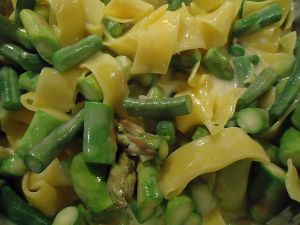I spoke too soon in my last post–it seems spring is still not here. I woke up to see snow on the ground and to hear little ice pellets clattering against the window. Since it’s a good day to stay indoors and sit by the fire, I have a hearty, wintertime recipe to share with you.
Until I made these beauties the other day, I had never made twice-baked sweet potatoes before. In fact, I had never made any kind of twice-baked potato before. Where had they been all my life??
Twice-baked sweet potatoes are, in fact, surprisingly easy to make, requiring very little effort and only a minimal amount of pre-planning (you’ll need about an hour and a half to make them, but only about 10-15 minutes of that time will be spent actually doing anything. The oven takes care of the rest!)
The recipe below is really more of a template–there are an infinite number of ways in which you could season your potatoes; I just pulled out a bunch of different spices that I thought would play well together and added them in, a bit at a time, til I had a flavor I was satisfied with. I ended up using a combination of Chinese five-spice, cayenne pepper, cumin, coriander, smoked paprika, cinnamon, and curry powder. The curry powder was a last minute addition, because it still wasn’t tasting quite right–had I thought of it sooner I probably could have eliminated the extra cumin, coriander, and cinnamon. Other spices that would work as well include ginger, cloves, nutmeg, and allspice. Or you could try adding a splash of maple syrup with some cayenne…there are a ton of different possibilities. The key is to add a little at a time, mix well, and taste. I ended up tasting the mix five or six times before I was satisfied.
Twice-Baked Sweet Potatoes
(serves 2)
- 2 medium sweet potatoes
- 3 oz soft goat cheese
- a pinch of raw cane sugar
- salt and pepper
- spices to taste (e.g. curry powder, five-spice, cayenne pepper, smoked paprika, cumin, coriander, ginger, etc)
Preheat the oven to 375 degrees.
Thoroughly scrub the sweet potatoes, and poke them all over with a fork. Put them in the oven, directly onto the middle rack, and put a baking sheet on the rack below to catch any drips. Bake for about an hour.
When the sweet potatoes are done baking, take them out of the oven, and cut a slit along the top of each potato, lengthwise. Gently push on the ends of each potato to open it up, and scoop the insides into a bowl with the goat cheese. Be careful not to tear the skins. Mix up the sweet potato flesh and goat cheese until fully incorporated. Then add the sugar, and the spices of your choice, a bit at a time. Add a pinch of salt and a few grinds of pepper, and mix thoroughly, tasting periodically as you adjust the spicing.
When you like the flavor, gently spoon the filling back into the sweet potato skins, put them on the baking sheet, and return them to the oven to bake for another 10 minutes or so until warmed through and slightly browned on top. Enjoy!









